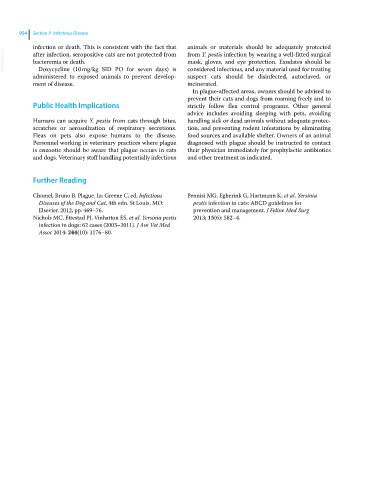Page 1016 - Clinical Small Animal Internal Medicine
P. 1016
954 Section 9 Infectious Disease
infection or death. This is consistent with the fact that animals or materials should be adequately protected
VetBooks.ir after infection, seropositive cats are not protected from from Y. pestis infection by wearing a well‐fitted surgical
mask, gloves, and eye protection. Exudates should be
bacteremia or death.
Doxycycline (10 mg/kg SID PO for seven days) is
administered to exposed animals to prevent develop considered infectious, and any material used for treating
suspect cats should be disinfected, autoclaved, or
ment of disease. incinerated.
In plague‐affected areas, owners should be advised to
prevent their cats and dogs from roaming freely and to
Public Health Implications strictly follow flea control programs. Other general
advice includes avoiding sleeping with pets, avoiding
Humans can acquire Y. pestis from cats through bites, handling sick or dead animals without adequate protec
scratches or aerosolization of respiratory secretions. tion, and preventing rodent infestations by eliminating
Fleas on pets also expose humans to the disease. food sources and available shelter. Owners of an animal
Personnel working in veterinary practices where plague diagnosed with plague should be instructed to contact
is enzootic should be aware that plague occurs in cats their physician immediately for prophylactic antibiotics
and dogs. Veterinary staff handling potentially infectious and other treatment as indicated.
Further Reading
Chomel, Bruno B. Plague. In: Greene C, ed. Infectious Pennisi MG, Egberink G, Hartmann K, et al. Yersinia
Diseases of the Dog and Cat, 4th edn. St Louis, MO: pestis infection in cats: ABCD guidelines for
Elsevier, 2012, pp. 469–76. prevention and management. J Feline Med Surg
Nichols MC, Ettestad PJ, Vinhatton ES, et al. Yersinia pestis 2013; 15(6): 582–4.
infection in dogs: 62 cases (2003–2011). J Am Vet Med
Assoc 2014: 244(10): 1176–80.

